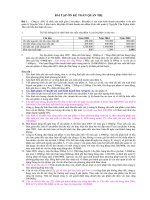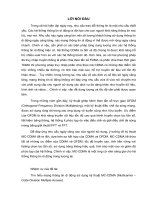technicalanalysis ichimoku 130801034312 phpapp01
Bạn đang xem bản rút gọn của tài liệu. Xem và tải ngay bản đầy đủ của tài liệu tại đây (923.64 KB, 15 trang )
Technical Analysis
- Ichimoku Cloud
1
Agenda
• Background
• The basic setup and calculations
• Buy and Sell signals
2
Background
• Introduced in 1969 by Goichi Hosada.
• Ichimoku Kinko Hyo meaning “equilibrium at a glance”
• Commonly applied in Asia and should be respected when
doing analyses on Asian instruments
• Based on a philosophy examining simple things in nature from
a mountain top and how they act in their respective
environment
3
In the MT4:
a) Tenkan-Sen
b) Kijun-Sen
c) Senkou Span A
d) Senkou Span B
e) Chinkou Span
4
Decomposition
1. Tenkan-sen is the average value of the price for the first time interval (nine days),
meaning:
𝑇𝑒𝑛𝑘𝑎𝑛 𝑆𝑒𝑛 =
𝐻𝑖𝑔ℎ𝑒𝑠𝑡 ℎ𝑖𝑔ℎ(9) + 𝐿𝑜𝑤𝑒𝑠𝑡 𝑙𝑜𝑤(9)
2
2. Kijun-sen is the average value of the price for the second time interval, 26 days.
𝐻𝑖𝑔ℎ𝑒𝑠𝑡 ℎ𝑖𝑔ℎ(26)+𝐿𝑜𝑤𝑒𝑠𝑡 𝑙𝑜𝑤(26)
𝐾𝑖𝑗𝑢𝑛 − 𝑆𝑒𝑛 =
2
3. Senkou Span A is the middle of interval between two above mentioned lines
(Tenkan-sen and Kijun-sen) projected 26 days in the future;
𝑇𝑒𝑛𝑘𝑎𝑛 𝑆𝑒𝑛 −𝐾𝑖𝑗𝑢𝑛 𝑆𝑒𝑛
𝑆𝑒𝑛𝑘𝑜𝑢 𝑆𝑝𝑎𝑛 𝐴 =
2
4. Senkou Span B is the average value of the price for the past 52 days projected 26
days into the future;
𝑆𝑒𝑛𝑘𝑜𝑢 𝑆𝑝𝑎𝑛 𝐵 =
𝐻𝑖𝑔ℎ𝑒𝑠𝑡 𝐻𝑖𝑔ℎ 52 − 𝐿𝑜𝑤𝑒𝑠𝑡 𝐿𝑜𝑤 (52)
2
5. Chinkou Span is the current closing price projected 26 days back
5
Interpretation
1. Tenkan-sen – also known as the Conversion Line – is interpreted as a simple
moving average.
2. Kijun-sen – also known as the Base Line – similar to the Tenkan-sen, but on a
longer time-frame.
3. Senkou Span A& B: The ingredients of the cloud. Area in between is shaded
illustrating the cloud. Composition gives an idea of future trend.
4. Chinkou Span is the current closing price projected 26 days back and is used for
comparison on the chart and defines potential trends.
6
Signals
When studying the Ichimoku Chart, it is important to notice the
following:
1. Cross of Tenkan-Sen and Kijun-Sen
2. Closing price against the Cloud
3. Position of Chinkou Span
4. Senkou Span A & B Composition/Cross
The more signals in sync, the stronger the signal. As always in
Technical Analysis, we are looking for CONFIRMATION.
7
Signals
Signal 1:
Cross of Tenkan-Sen (red)
and Kijun-Sen (blue)
Bullish:
Red line closes above blue.
Bearish:
Red line closes below blue.
8
Signals
Signal 2:
Closing price relative to Cloud…
Bullish
Bullish Tendency
Interpretation
Price Action
Bullish
Price above Cloud with bullish
momentum
Bullish Tendency
In the Cloud, but past 2-3 days
bullish
Bearish
Price below Cloud with bearish
momentum
Bearish Tendency
In the Cloud, but past 2-3 days
bearish
Bearish
Tendency
Bearish
9
Signals
Signal 3:
Position of Kinjun-Sen
(Green line)
Bullish
Bullish:
Kinjun-Sen crosses above the
closing price
Bearish:
Kinjun-Sen crosses below the
closing price
Remember that the KinjunSen is lagging 26 days and is
also known as the “lagging
mountain”
Bearish
10
Signals
Rising Market
Declining Market
Signal 4:
Senkou A & B relationship
A is above B is a sign of a
rising market.
A is below B is a sign of a
declining market.
11
Example 1
12
Example 2
13
Example 3
14
Indicator
Example 1
CAD/JPY Daily
Example 2
AUD/JPY Daily
Example 3
EUR/JPY Daily
Tenkan-Sen vs.
Kijun-Sen
Bullish
Bearish
Bullish
Closing vs.
Cloud
Indecisive
Bearish
Bullish
Cloud
Composition
Declining
Market
Declining
Market
Declining
Market
Chinkou-Span
Positive
Negative
Positive
15









